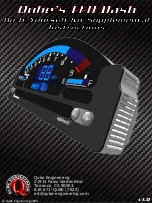
--10--
Connection "Display":
Plug-type connection for either a LED Remote Control S (order No. 2076) or an LCD Charge Control S-VCC (order No. 1248).
Further information can be found in the corresponding operating manual.
Battery Temperature Sensor:
Connect the temperature sensor (included in the standard delivery scope) to the
terminals "T T"
(any polarity).
The temperature sensor controls the
temperature
of the board supply
battery
.
Ensure that the installation place of the sensor is not influenced by any source of heat (engine heat, exhaust, heater
etc.)!
Lead-Acid, Gel, AGM Batteries:
Installation:
The
thermal contact
of sensor and
battery inside temperature should be well.
Thus, it should be screwed
down to the negative pole or positive pole of the battery. It is also possible to fasten it at the sidewall centre of the battery
casing.
Function:
The temperature-dependent charging voltage of the board battery will be adapted automatically to the battery
temperature (automatic temperature equalization).
For this purpose, the temperature sensor measures the battery
temperature. In case of low temperatures (winter operation), the charging voltage will be increased in order to improve
and accelerate full charging of the weak battery. Sensitive consumers are protected by a voltage limitation in case of very
low outside temperatures.
In case of summery temperatures, the charging voltage is reduced to minimize the load (gassing) of the battery and to
extend the lifetime of gas-tight batteries.
Battery Protection:
In case of excessive battery temperatures (from +50 °C), the charging voltage will be reduced strongly
to the
safety charging voltage
of approx. 12.80 V for battery protection, and the maximum charging current rate will be
halved
(safety mode, LED
"Board OUT" is flashing
). Any charging data being recorded hitherto will be kept in memory.
Battery charging is then interrupted, but the supply of possibly connected consumers will be continued by the unit, and the
battery is allowed to cool down. After that, automatic charging will be resumed. Also refer to:
"Lead batteries, 4 characteristic lines
, charging voltage rates and
temperature equalization"
from
page 11.
The unit recognizes automatically a missing sensor, cable break or short circuit of the sensor cables, as well as unreasonable
measuring values. In that case, it will switch automatically to the usual charging voltage rates of 20 °C / 25 °C being
recommended by the battery manufacturers.
LiFePO4 Batteries:
Installation:
The
thermal contact
of sensor and
inside temperature
of the battery
should be well
. Thus, it should be
screwed down to the
negative pole
of the battery, because in most of the cases, this is the cooler side (the positive pole is
often biased by the exhaust heat of internal fuses of the battery, electronic systems for cell equalization, balancers etc.)
Function:
In case of abnormal battery temperatures, such as < -20 °C, > 50 °C, the charging voltage will be reduced strongly
to the
safety charging voltage
of approx. 12.80 V for battery protection, and the maximum charging current rate will be
halved (safety mode, LED
"Board OUT" is flashing
). Any charging data being recorded hitherto will be kept in memory.
Battery charging is then interrupted, but the supply of consumers being possibly connected will be continued by the
charger until the battery temperature is again within the acceptable range. After that, automatic charging will be resumed.
In case of temperatures
below 0 °C
,
the charging current will be reduced considerably for battery protection
, the LED
"Board OUT"
will turn off every 2 seconds, and longer charging times can be expected. Also refer to
4 Characteristic Lines
for "
LiFePO4
Batteries, Charging Voltage Rates and Temperature Control", from
page 12
.
Warning: If the charging characteristic line had been set for a LiFePO4 battery, the temperature sensor
must be connected for reasons of battery safety. Otherwise, the unit will not operate, and the LED
"Main
Charge"
will be
flashing
!
Option:
Several Batteries at the Charging Port:
Parallel charging of two or several batteries of the same voltage (12 V) is admissible. For this purpose, the batteries are
connected "in parallel". The capacity values (Ah) are summed up.
The total capacity (total Ah) should not exceed the
recommended maximum battery capacity.
According to the battery manufacturers,
permanent parallel operation
is admissible in case of two or several batteries of
the same voltage, same type, same capacity, and of about the same age (history).
Example: Connection in parallel of 2 batteries (cross connection):
Both positive poles must be connected with a powerful cable. Also both negative poles must be connected with a powerful
cable.
Now, the supply cables are connected advantageously "in cross connection", which means
Minus supply cable at negative pole of battery "1".
Plus supply cable at positive pole of battery "2".
This ensures that both batteries "1" and "2" of the system will receive/supply the same voltage.





































